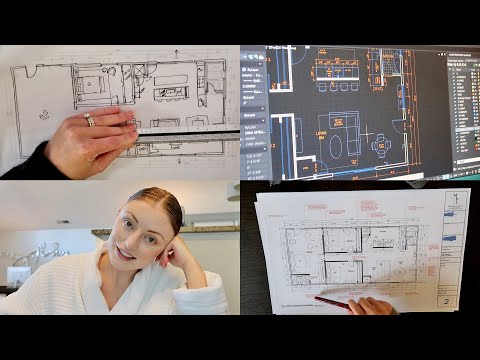Interior Designer Job: Description & Salary
Interior Designer Job Description: An interior designer is responsible for planning, designing, and executing the interiors of residential or commercial spaces. They work closely with clients to understand their needs and preferences, and then create functional and aesthetically pleasing designs that meet those requirements. Interior designer job description involves conducting site visits, taking measurements, and creating detailed floor plans and 3D models. They select and specify materials, furniture, lighting, and other fixtures, ensuring they align with the design concept and budget.
Interior Designer Salary: The salary of an interior designer can vary based on factors such as experience, location, and employer. On average, interior designers earn a median annual salary of around $56,000. Entry-level designers may start with a lower salary, while highly experienced and renowned professionals can earn well over $100,000 per year. Additionally, designers who work independently or have their own firms have the potential to earn higher incomes as they can set their own rates and fees.
In conclusion, interior designers play a crucial role in transforming spaces into functional and visually appealing environments. With a competitive salary range and the opportunity to unleash their creativity, interior design is a promising career choice for those with a passion for aesthetics and spatial design.

Interior Designer Job Description Template
Interior Designer Job Description
Interior designers are professionals who plan and create functional and aesthetically pleasing interior spaces. They work closely with clients to understand their needs, preferences, and budget, and then develop design concepts that meet these requirements.
Attention to detail is crucial for an interior designer as they must consider every aspect of a space, including the layout, color scheme, lighting, furniture, and accessories. They need to have a keen eye for creativity and be able to think outside the box to create unique and innovative designs that reflect the client’s personality and style.
In addition to designing the overall look and feel of a space, interior designers also select and source materials, furniture, and fixtures that align with the design concept. They work with contractors and suppliers to ensure that the project is executed smoothly and within the defined timeline and budget.
Interior designers need to have strong communication and interpersonal skills as they regularly interact with clients, contractors, and other professionals involved in the project. They must be able to effectively communicate their design ideas and concepts to clients and collaborate with others to bring the vision to life.
To be successful in this role, interior designers should have a bachelor’s degree in interior design or a related field, along with relevant work experience. They should also possess a good understanding of building codes, regulations, and industry standards. Proficiency in design software and knowledge of current design trends are also important.
Overall, interior designers play a vital role in transforming ordinary spaces into functional and visually appealing environments that enhance the quality of life for the occupants. Their expertise and creativity contribute to creating unique and personalized spaces that meet the needs and desires of their clients.
Interior Designer Responsibilities
Interior Designer Requirements
How Much Does A Interior Designer Make?
Interior Designer Salary
| Experience Level | Annual Salary |
|---|---|
| Entry Level | $40,000 – $55,000 |
| Mid-Level | $55,000 – $75,000 |
| Senior Level | $75,000 – $100,000 |
An interior designer’s salary varies based on their level of experience. Entry-level interior designers can expect to earn between $40,000 and $55,000 annually. Mid-level interior designers typically earn between $55,000 and $75,000 per year. Senior-level interior designers, with extensive experience and expertise, can earn between $75,000 and $100,000 annually. It’s important to note that these figures can vary depending on factors such as location, employer, and individual skills. Overall, a career in interior design offers competitive salaries and opportunities for growth.
Interior Designer Salaries by Country
Top Paying Countries for Interior Designer
| Country | Average Salary |
|---|---|
| Switzerland | $89,400 |
| United States | $69,890 |
| Australia | $61,500 |
| United Arab Emirates | $49,680 |
| Canada | $46,800 |
An interior designer’s salary can vary greatly depending on the country they work in. Switzerland tops the list as the highest paying country for interior designers, with an average salary of $89,400. The United States follows closely behind with an average salary of $69,890. Australia, United Arab Emirates, and Canada also offer competitive salaries for interior designers, ranging from $46,800 to $61,500.
A video on the topic Interior Designer
Interview Questions for Interior Designer
1. What attracted you to the field of interior design?
I have always had a passion for creating aesthetically pleasing and functional spaces. Interior design allows me to combine my creativity and problem-solving skills to transform ordinary spaces into extraordinary ones.
2. How do you approach a new project?
When starting a new project, I begin by gathering information about the client’s needs, preferences, and budget. I then conduct research and create mood boards to develop a concept. After that, I create floor plans, select materials and furnishings, and present the design to the client for feedback before proceeding with the implementation.
3. What is your design style and how do you tailor it to fit each client’s unique taste?
My design style can be described as contemporary with a touch of minimalism. However, I believe in adapting my style to suit each client’s individual taste and preferences. I take the time to understand their desired aesthetic and incorporate elements that resonate with their personal style, while still maintaining a cohesive design.
4. How do you stay updated with the latest design trends and materials?
I regularly attend industry events, trade shows, and design exhibitions to stay updated with the latest design trends. Additionally, I follow design blogs, read design magazines, and collaborate with other professionals in the field. This allows me to stay informed about new materials, finishes, and techniques that can enhance my designs.
5. Can you describe a challenging project you have worked on and how you overcame the obstacles?
I once worked on a project where the client had a limited budget but desired a luxurious and high-end look. To overcome this challenge, I focused on sourcing affordable alternative materials that mimicked the desired aesthetic. I also utilized clever space planning and incorporated strategic lighting to create a sense of luxury without exceeding the budget.
6. How do you handle working within a specific budget?
Working within a specific budget requires careful planning and prioritization. I analyze the client’s budget and allocate resources accordingly, giving priority to key areas that will have the most impact. I also have a network of suppliers and vendors that offer competitive pricing, allowing me to maximize the budget while still delivering a high-quality design.
7. How do you ensure that your designs are both functional and visually appealing?
I believe that functionality is as important as aesthetics in interior design. To ensure that my designs are both functional and visually appealing, I consider the client’s lifestyle, needs, and habits. I focus on creating efficient layouts, incorporating ample storage solutions, and selecting furniture and materials that are not only beautiful but also practical for everyday use.
8. How do you handle disagreements or conflicts with clients during the design process?
Open and effective communication is key when resolving disagreements or conflicts with clients. I always strive to listen to their concerns and find a compromise that satisfies both parties. I am flexible and willing to make adjustments to the design if necessary, as long as it aligns with the client’s vision and objectives.
9. Can you explain your process for collaborating with architects, contractors, and other professionals?
I believe that collaboration is essential for successful interior design projects. I start by establishing clear lines of communication and setting expectations with all parties involved. I work closely with architects and contractors during the planning and construction phases to ensure that the design is implemented accurately. Regular meetings and site visits are also conducted to address any issues or make necessary adjustments.
10. How do you approach sustainability and eco-friendly design in your projects?
I am committed to incorporating sustainable and eco-friendly design practices in my projects. I prioritize the use of environmentally friendly materials, such as recycled or repurposed items, low VOC paints, and energy-efficient lighting. I also focus on designing spaces that promote natural light and ventilation, reducing the need for artificial heating and cooling. Additionally, I encourage clients to invest in durable and long-lasting furniture and fixtures to minimize waste.






